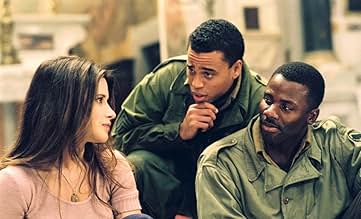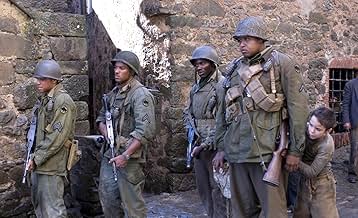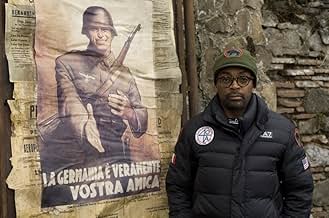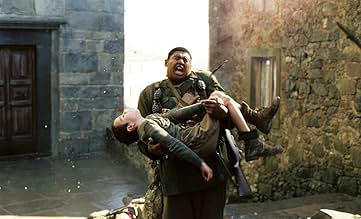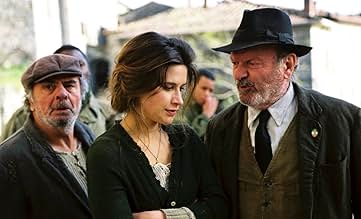VALUTAZIONE IMDb
6,1/10
19.504
LA TUA VALUTAZIONE
Ambientato nel 1944 in Italia, la storia di quattro soldati neri americani che rimangono intrappolati in un villaggio toscano durante la seconda guerra mondiale.Ambientato nel 1944 in Italia, la storia di quattro soldati neri americani che rimangono intrappolati in un villaggio toscano durante la seconda guerra mondiale.Ambientato nel 1944 in Italia, la storia di quattro soldati neri americani che rimangono intrappolati in un villaggio toscano durante la seconda guerra mondiale.
- Premi
- 1 vittoria e 10 candidature totali
Lidia Biondi
- Natalina
- (as Lydia Biondi)
Recensioni in evidenza
I attended the world premier of Miracle at St. Anna at Toronto International Film Festival. Unfortunately as much as I respect Spike Lee as a filmmaker I thought the movie was a bit dull and kind of boring. At 166 minutes I found that the movie was overlong and dragged too much. I became restless after awhile as the movie progressed. The story didn't seem to go anywhere, was uninteresting and I had trouble connecting with it. It was hard to follow at times as well. The movie jumped all over the place at several points to different years in the history of the characters. I found this to be jarring and irritating. Spike Lee should have taken more time to edit his film because each of the scenes went longer than they should have. It's not the worst movie I have ever seen although it could have been better. My expectations were high. I came away somewhat disappointed.
A funny thing happens when you're counted among the preeminent talents in any contemporary art form: Everything you do must approach sublime... or else. Something less funny happens when your art is as socially outspoken as Spike Lee's body of work: Folk wait with baited breath to name every shred of detail that marks your work as somehow less than sublime. And in so doing, they ever miss the forest for the trees.
Lee's latest "joint," MIRACLE AT ST. ANNA, based on James McBride's novel of the same name, no doubt will suffer from such deconstruction, some of which will be justified. At 160+ minutes, the fictional recollection of four black American WWII soldiers who get trapped in an Italian village during a German insurgence, can wax tedious. And Lee's defaulting to certain conventions of the war genre and his own signature style occasionally comes off forced, sentimental, even ridiculous. After, say, the 10th close-up of a slain human -- eyes still open in horror -- we may not need to see an 11th, 12th, 13th. And any casual student of cinema might spot Lee's attempted tear-jerker ending a la CINEMA PARADISO coming a mile away.
Then there are the technical shortcomings of personnel who should know better: A score by Terence Blanchard is uncharacteristically overwrought; cinematography by Matthew Libatique is alternately breathtaking and obtuse; and a self-adapted screenplay by McBride suffers from a conspicuously uncommitted point of view. But, indeed, what may most undercut any visceral charm of MASA is at once admirably realistic: The film's characters aren't particularly moving in their conflicted natures and utter lack of romance. Only a visionary Italian boy, played beautifully by newcomer Matteo Sciabordi, and the black American soldier who befriends him, played by the hulking Omar Benson Miller, elicit any real sympathy.
All told, the numerous missteps do not seriously undercut a captive tale of humans -- white, black and brown -- who find themselves thrown into a hell not of their making and forced to juggle universal sensibilities with the duties of their divergent identities. In this regard, Lee's latest shows marked progress: Gone are the one-sided depictions of whites. Fascist-era native Italians are shown here in all their warring complexity; American actor D.B. Sweeney plays a key, if understated, role as a white U.S. colonel opposed to the exploitation of the all-black 92nd Army Division; even Nazi stormtroopers here are given back a modicum of humanity. Neither is the African American experience sanctified: Actor Michael Ealy's preacher-turned-soldier character is equal parts charming and vile; and one pre-Civil Rights-era American flashback begs the question of what line separates hero and villain. If one is willing to forgive the imperfect details from a filmmaker who has proved capable of better, the aggregate statement is hardly ineffectual.
Lee's real victory here shouldn't be missed. MASA does not rise to the level of the best of the genre. Neither is it worthy to be called the definitive tribute to an unsung 92nd Army Division or the souls lost at Sant'Anna di Stazzema. But it is always watchable, always interesting -- and as an engaging enough mystery film and thoughtful ensemble piece with an important, forgotten corner of human failure as backdrop, it succeeds.
Lee's latest "joint," MIRACLE AT ST. ANNA, based on James McBride's novel of the same name, no doubt will suffer from such deconstruction, some of which will be justified. At 160+ minutes, the fictional recollection of four black American WWII soldiers who get trapped in an Italian village during a German insurgence, can wax tedious. And Lee's defaulting to certain conventions of the war genre and his own signature style occasionally comes off forced, sentimental, even ridiculous. After, say, the 10th close-up of a slain human -- eyes still open in horror -- we may not need to see an 11th, 12th, 13th. And any casual student of cinema might spot Lee's attempted tear-jerker ending a la CINEMA PARADISO coming a mile away.
Then there are the technical shortcomings of personnel who should know better: A score by Terence Blanchard is uncharacteristically overwrought; cinematography by Matthew Libatique is alternately breathtaking and obtuse; and a self-adapted screenplay by McBride suffers from a conspicuously uncommitted point of view. But, indeed, what may most undercut any visceral charm of MASA is at once admirably realistic: The film's characters aren't particularly moving in their conflicted natures and utter lack of romance. Only a visionary Italian boy, played beautifully by newcomer Matteo Sciabordi, and the black American soldier who befriends him, played by the hulking Omar Benson Miller, elicit any real sympathy.
All told, the numerous missteps do not seriously undercut a captive tale of humans -- white, black and brown -- who find themselves thrown into a hell not of their making and forced to juggle universal sensibilities with the duties of their divergent identities. In this regard, Lee's latest shows marked progress: Gone are the one-sided depictions of whites. Fascist-era native Italians are shown here in all their warring complexity; American actor D.B. Sweeney plays a key, if understated, role as a white U.S. colonel opposed to the exploitation of the all-black 92nd Army Division; even Nazi stormtroopers here are given back a modicum of humanity. Neither is the African American experience sanctified: Actor Michael Ealy's preacher-turned-soldier character is equal parts charming and vile; and one pre-Civil Rights-era American flashback begs the question of what line separates hero and villain. If one is willing to forgive the imperfect details from a filmmaker who has proved capable of better, the aggregate statement is hardly ineffectual.
Lee's real victory here shouldn't be missed. MASA does not rise to the level of the best of the genre. Neither is it worthy to be called the definitive tribute to an unsung 92nd Army Division or the souls lost at Sant'Anna di Stazzema. But it is always watchable, always interesting -- and as an engaging enough mystery film and thoughtful ensemble piece with an important, forgotten corner of human failure as backdrop, it succeeds.
As a black man who fully believes in black pride and progress, I must say I am truly disappointed with spike lee's new movie right now. I don't know where to begin in regards to expressing my disappointment but I will try. Considering how spike tries to come off as being very afro-centric, his portrayal of black characters was very insulting. There were so many typical blacks in film stereotypes in the movie that I just shook my head most of the time. For instance you had a black man with a gold tooth and stocking cap on, another that was enormous in size but brainless and country, and then to put the cherry on top the 2 guys are fighting over a white woman they met like 2 days ago and kept drooling over. Contrary to popular belief most of the white American soldiers didn't look like the actors in the movies made in the 50's and 60's. The actors looks were ploy to just associate good looks and chivalry with American soldiers in order to build moral for soldiers when they left and came home and to keep ppl interested in the movie. Another thing that really bothered me was that black films don't always need to be funny or trying to evoke laughter. This movie was suppose to be dramatic touching upon a serious subject and should have been directed in the same manner. Then the scoring of the movie was horrible. Even the little parts where he tries to show difference between African Americans and black puerto ricans was off and unnecessary. During that time those hispanics that were black or mulatto didn't try to act like there was a difference between the 2 other than language and maybe certain foods because they faced the same discriminations in PR, DR, and CUBA as in the US. These are just some of the issues I had with this movie. I think antoine faqua, who did training day and arthur, should have done this movie. I am just waiting now to see the mockery of hannibal that vin diesel does.
MIRACLE AT ST. ANNA got panned pretty severely. And I can see why. Lacking cohesion and hopscotching around like a child with A-D-D, the story is tough to follow. And what about the title? Exactly what is "the Miracle"? Some might say it's that this film ever got made. But there are some upsides to it that I think make this a semi-watchable flick.
The first plus is that it focuses on a little known regiment of black WW II fighters called "The Buffalo Soldiers." Spike Lee had apparently been aching to do another "black story" and found his muse in Nazi occupied Italy.
Although there's been some bashing related to overacting on the main characters' parts, I didn't find that to be the case. Derek Luke, Michael Ealy, and the rest of these band of brothers did fine in my eyes. Although Spike did have them doing things that weren't being done during this time (specifically the "high five" which wasn't realized until the late 70s), I did find their delivery of the story to be engaging enough, and kept me watching during its entire, lengthy, 2 hours and 40 minute run time.
I also really liked the on-site filming locations in Italy, which gave the entire production a very real quality. The cobbled streets, twisted landscape, and ancient-looking buildings were all well-shown in the film and had me ogling at various times.
But, as they say, all good things must come to an end. Although Spike Lee tries admirably to keep the story together, he too often wanders off on tangents that have nothing to do with the story. One particularly infuriating scene involves John Leguizamo (THE HAPPENING). He's in modern day Italy with his lover and his only use for being in the film is that he throws a newspaper out a window so that it lands on a man's table. Why couldn't the man have simply seen it at a newsstand? Why the whole set up with Leguizamo and the hot chick? Sex for the sake of sex, perhaps? The other, less infuriating, item that shows Spike wandering away was when he films the Buffalo boys being refused food service at a place back in the States before they were shipped overseas. Why this played a role in the film and what it had to do with the Miracle is anyone's guess.
Finally, there's the tough sell of the Miracle itself. Although people can debate what qualifies as a miracle, I think most would say it equates to something supernatural that cannot be explained by normal evidence. And here lies perhaps the biggest problem for Miracle at St. Anna. There really isn't a miracle. Perhaps it's well enough that one of the Buffalo men made it home and found his way to peace. Perhaps it's that the world spun and allowed the last surviving Buffalo Soldier to avenge the people of St. Anna and his fallen brothers. Perhaps ...but not likely.
The first plus is that it focuses on a little known regiment of black WW II fighters called "The Buffalo Soldiers." Spike Lee had apparently been aching to do another "black story" and found his muse in Nazi occupied Italy.
Although there's been some bashing related to overacting on the main characters' parts, I didn't find that to be the case. Derek Luke, Michael Ealy, and the rest of these band of brothers did fine in my eyes. Although Spike did have them doing things that weren't being done during this time (specifically the "high five" which wasn't realized until the late 70s), I did find their delivery of the story to be engaging enough, and kept me watching during its entire, lengthy, 2 hours and 40 minute run time.
I also really liked the on-site filming locations in Italy, which gave the entire production a very real quality. The cobbled streets, twisted landscape, and ancient-looking buildings were all well-shown in the film and had me ogling at various times.
But, as they say, all good things must come to an end. Although Spike Lee tries admirably to keep the story together, he too often wanders off on tangents that have nothing to do with the story. One particularly infuriating scene involves John Leguizamo (THE HAPPENING). He's in modern day Italy with his lover and his only use for being in the film is that he throws a newspaper out a window so that it lands on a man's table. Why couldn't the man have simply seen it at a newsstand? Why the whole set up with Leguizamo and the hot chick? Sex for the sake of sex, perhaps? The other, less infuriating, item that shows Spike wandering away was when he films the Buffalo boys being refused food service at a place back in the States before they were shipped overseas. Why this played a role in the film and what it had to do with the Miracle is anyone's guess.
Finally, there's the tough sell of the Miracle itself. Although people can debate what qualifies as a miracle, I think most would say it equates to something supernatural that cannot be explained by normal evidence. And here lies perhaps the biggest problem for Miracle at St. Anna. There really isn't a miracle. Perhaps it's well enough that one of the Buffalo men made it home and found his way to peace. Perhaps it's that the world spun and allowed the last surviving Buffalo Soldier to avenge the people of St. Anna and his fallen brothers. Perhaps ...but not likely.
Lee makes a European film allowing philosophical questions and moral questions to supplant desire for personal satisfaction and identifiable this is a Spike Lee film signature patterns. There are a number of excellent directorial decisions in this film. Lee's camera is sensitive, gentle and sincere. He shows us the many ways our eyes are deceived and how much of what we perceive is illusion. I think its a great film that is inspirational, has meaning and is both emotionally and intellectually satisfying. I hope that Lee will continue to make films outside his comfort zone and articulate events from the African American experience around the world to show our contribution to history and civilization.
Lo sapevi?
- QuizSamuel L. Jackson turned down the offer to play as Corporal Hector Negron to work on La terrazza sul lago (2008).
- BlooperWhen the professor examines the marble head he recognizes it as the "Primavera" from Santa Trinità in Florence. He assumes it is by Bartolomeo Ammannati, but the bridge is by Ammannati; the sculpture is by Pietro Francavilla.
- Citazioni
Livingston: Safety is the greatest risk of all, because safety leaves no room for miracles and miracles are the only sure thing in life.
- Colonne sonoreFaccetta Nera
Written by Gustavo Cacini (as Cascini) / Giuseppe Micheli (as Micheli) / Vincenzo Raimondi / Arnaldo Stazzonelli (as Stazzonelli)
Edizioni Bixio C.E.M.S.A.
I più visti
Accedi per valutare e creare un elenco di titoli salvati per ottenere consigli personalizzati
Dettagli
- Data di uscita
- Paesi di origine
- Sito ufficiale
- Lingue
- Celebre anche come
- Miracle at St. Anna
- Luoghi delle riprese
- Aziende produttrici
- Vedi altri crediti dell’azienda su IMDbPro
Botteghino
- Budget
- 45.000.000 USD (previsto)
- Lordo Stati Uniti e Canada
- 7.919.117 USD
- Fine settimana di apertura Stati Uniti e Canada
- 3.477.996 USD
- 28 set 2008
- Lordo in tutto il mondo
- 9.333.654 USD
- Tempo di esecuzione2 ore 40 minuti
- Colore
- Mix di suoni
- Proporzioni
- 2.39 : 1
Contribuisci a questa pagina
Suggerisci una modifica o aggiungi i contenuti mancanti







